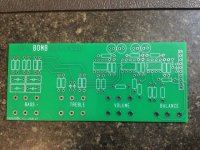So i found this passive bass treble board on Aliexpress that seems somewhat decent imo
https://a.aliexpress.com/_oFtNCp8
İ am thinking of using it between the preamp and the power amp section of a diy tube amp
İ have a few questions about it tho
What would be the cons of using a passive board over a active one
İn the description of the board it says that the output gain is 0.5 which is half of input gain would that be a huge loss and does it mean it outputs %50 less sound than the input
Thanks in advance,
https://a.aliexpress.com/_oFtNCp8
İ am thinking of using it between the preamp and the power amp section of a diy tube amp
İ have a few questions about it tho
What would be the cons of using a passive board over a active one
İn the description of the board it says that the output gain is 0.5 which is half of input gain would that be a huge loss and does it mean it outputs %50 less sound than the input
Thanks in advance,
The only cons I say is that the amplitude of the audio from a tube set may overload the input of the new tone control. Take it at mind.
Yes, it does mean it outputs 50% of the signal, or -6dB. It will likely only have +/-5dB of boost/cut range too. The version of one that has a full +/-12 or 15 dB range will have even more loss at mid setting. Tube amp builders will usually make that up with an extra gain stage before the tone controls. Tubes run on high enough voltage that they don’t run out of headroom as easily as op amps do. Tubes can be configured as active Baxandall type feedback tone controls, but many builders (not even just the purists) prefer the passive tone controls.
Looks like a very poor design.
Standard passive tone controls use Audio/Log pots , so pot sections when set to "5" or halfway show a 10:1 resistance ratio.
Net impedances are also in a 10:1 ratio, so you will find, say, 2n2/22nF caps for treble, 10nF/100nF for bass or something similar.
This one shows same value at boost and cut sections.
Designer probably used active Baxandall values which are symmetrical.
Of course, terrible performance if used passive.
To the OP: junk this board and just build a proper Tone Control.
You do not even need a PCB, you can mount most components (which are very few) straight on pot legs.
Standard passive tone controls use Audio/Log pots , so pot sections when set to "5" or halfway show a 10:1 resistance ratio.
Net impedances are also in a 10:1 ratio, so you will find, say, 2n2/22nF caps for treble, 10nF/100nF for bass or something similar.
This one shows same value at boost and cut sections.
Designer probably used active Baxandall values which are symmetrical.
Of course, terrible performance if used passive.
To the OP: junk this board and just build a proper Tone Control.
You do not even need a PCB, you can mount most components (which are very few) straight on pot legs.
“Audio” taper pots are really only 8:1, not true “Log” taper. With 10:1 capacitors you get a mild boost at both ends with the controls in the center. “Stereos” with bass and treble controls tend to “sound better” to the casual user because of this. And people looking for flat response avoid them like the plague. You can make it flat in the center with 8:1 capacitors. I have seen it done occasionally on “premium” vintage gear, and do it this way myself.
Linear taper for passive results in a narrow boost/cut range since the change in impedance is only 2:1. Some people do like that. Most don’t.
No, you don’t need a PCB but when adding op amps and making modular systems it helps. This one is an active Baxandall…. And if some smartass asks if you’re building a bomb, you can say YES!
Linear taper for passive results in a narrow boost/cut range since the change in impedance is only 2:1. Some people do like that. Most don’t.
No, you don’t need a PCB but when adding op amps and making modular systems it helps. This one is an active Baxandall…. And if some smartass asks if you’re building a bomb, you can say YES!
Attachments
I know that there were 10, 20 and 50% of the maximum resistive value when at half shaft rotation, and some S shaped for good Baxandall implementations. But I ignore at today if it still is so.
